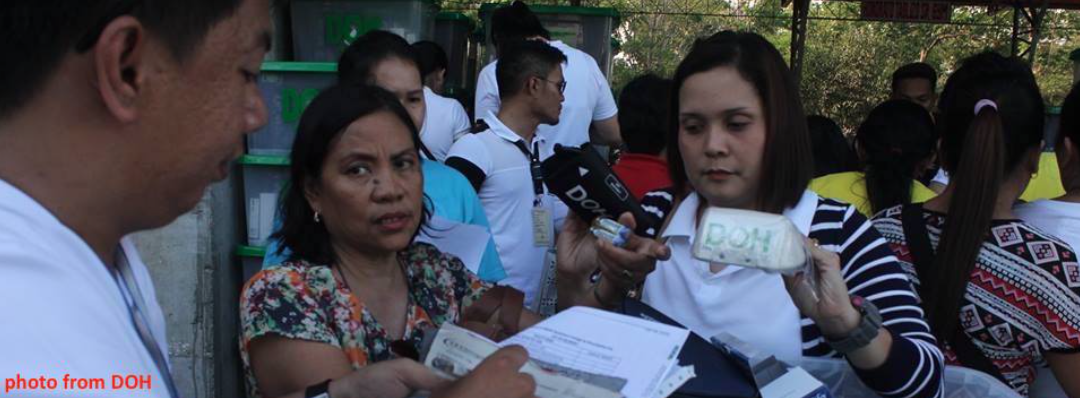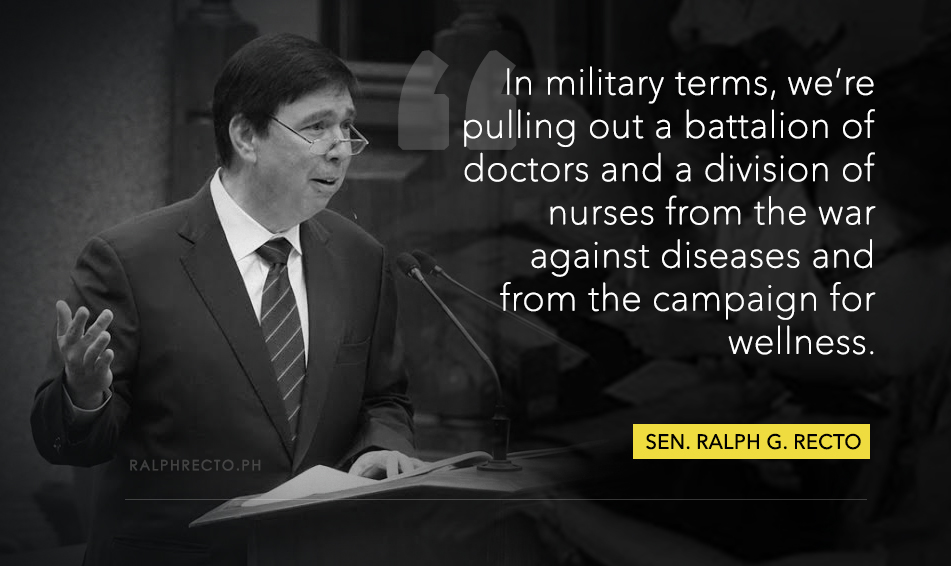Gov’t plans to slash number of rural doctors by half, nurses by one-third
The Department of Health (DOH) is slashing by one-half the number of doctors and by one-third the number of nurses it plans to deploy to the grassroots next year, Senate Minority Leader Ralph Recto revealed today.
The DOH also intends to send out fewer dentists to public health facilities, Recto said, comparing the DOH’s health manpower deployment plan for 2017 with the current year.
Recto said that under the agency’s Doctor to the Barrios program, the number of physicians assigned to low-income towns will go down from 946 this year to 435 next year, or 511 fewer.
But it is in the deployment of nurses where the biggest cut is observed – from 15,727 this year to 9,349 in 2017, which means 6,368 nurses contracted under the Nurse Deployment Program will be axed.
“In military terms, we’re pulling out a battalion of doctors and a division of nurses from the war against diseases and from the campaign for wellness,” Recto said.
The senator said the number of DOH-paid dentists who will be assigned to rural clinics will also be reduced from the 2016 level of 324 to 243 next year.
To augment the number of health professionals in impoverished towns, the DOH pays for the salaries of those it has hired under the Rural Health Practice Program (RHHP).
However, RHHP slots will be slashed from the current 21,118 to 18,825 next year.
Recto said he will ask Health officials to explain the personnel cuts when they appear before the Senate this month to justify their proposed P141.6 billion budget for 2017.
“Are local governments assuming the pay of doctors and nurses currently assigned to them? Is there a hiring binge in local government units using local funds? Or could it be due to an across-the-board decline in the number of sick people, that diseases are down?” Recto asked.
“Are there few applicants that they want to bring it down to a more realistic level?” Recto said. “Or is it simply a case of not having enough funds to bankroll the assignment of these people?”
Recto believes the DOH “has been forced to cut the number of ‘untenured’ personnel due to the need to provide budget space for the second round of salary increases under the Salary Standardization Law IV.”
Recto said if it is due to funding lack, “then the Senate should transfuse funds to this program, to be sourced from non-essential items in the proposed 2017 national budget.”
While fewer doctors, nurses and dentists will be dispatched, the number of medical technologists and midwives hired would stay at 308 and 3,100 respectively.
And from 713 public health associates (PHAs) deployed this year, DOH is asking for funds to hire “2,587 UHC (Universal Health Coverage) implementers and 2,803 PHAs,” whose job descriptions are not, however, stated in the DOH proposal.
“Ito ba ang mga papalit sa mga doktor at nurses? Kung sila, handa naman tayo makinig sa paliwanag ng DOH kung bakit ganoon. Umaasa ako na sana mayroong magandang batayan,” Recto said.
“I am keeping an open mind and hope to be convinced why such personnel changes are needed for public health to be served better, “Recto said.
In all, 21,118 DOH-paid health professionals are being sent to public hospitals, rural health units, and clinics run by local governments under the RHPP with a budget of P7.1 billion. Although this funding level will be retained next year, the number of personnel hired will go down to 18,825.
Under the existing government “division of labor,” health services are devolved to local governments, which run provincial and district hospitals, and municipal and city health offices. The DOH, however, retains control of regional hospitals and major medical centers.
“So that national government will have local presence, the RHPP was designed as its contribution to the local health manpower pool,” Recto explained.




